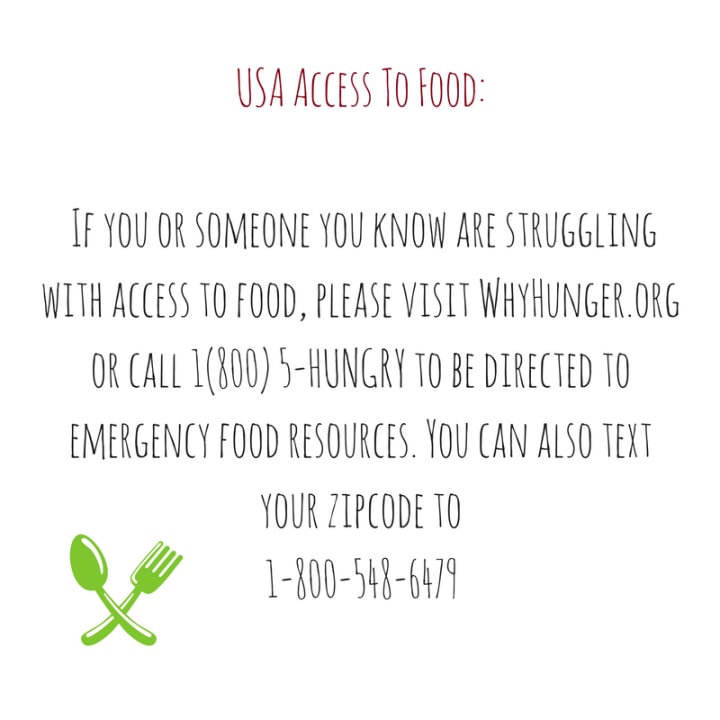
Hunger and food insecurity are global problems that are found in every single country and across community demographics.
How do we define hunger vs. food insecurity?
Food insecurity is a household-level economic and social condition of limited or uncertain access to adequate food. Hunger is an individual-level physiological condition that may result from food insecurity. (USDA)
Facts:- Globally, according to the United Nations, 800 million people currently live in hunger and 39 countries have been identified thus far this year (2018) as needing external food aid in order to feed their people. That's 13 percent of the global population or roughly one in nine people on this planet.
- Nationally, according to the U.S.based non-profits No Kid Hungry and Feeding America, 41.2 million Americans live in food-insecure homes. Breaking that down further—that's 28 million adults and 13 million U.S. kids currently living in food insecure homes. One in six American kids live in food insecure homes.
- Furthermore, according to a report launched on June 9, 2018, by the U.N. Agricultural Agency, "Hunger is surging [this year] amid deadly conflicts and poor weather conditions in many countries." (U.N. News)
The United Nations has set a goal of eradicating extreme hunger by 2030—yet currently 800 million people in the world live in hunger. (IPS News Agency)
On top of that, the World Bank estimates that climate change could cut crop production by as much as 25 percent over the coming years.
Solutions to extreme hunger won't be solved in a day. They will require policy changes on a global scale. It will require a shift in how we approach food and food waste. Believe it or not, according to the Global Food Security Primer the world actually does produce enough food to feed everyone right now (this is expected to change by 2050) but extreme economic inequality prevents distribution of that food.
We don't have a food supply problem, we have a food injustice problem.
So what do we do?
How can we—as ordinary people—work together to change how food and access to food happens in our community and our world?
1. Strengthen and support grassroots efforts.

Support local efforts!
Locally: There are likely already community programs in your area (co-ops, community gardens, farmers markets etc.) that are attempting to address the issue of community hunger. Support them and help them grow. Building a strong local food economy is essential for battling hunger and food insecurity. The American Community Gardening Association has a great map tool that you can use to find a community garden near you! If you don't have one, you can also find information on how to start one!Globally: Support programs that advocate for a community-based approach to food aid. Programs like Kiva Microloans are a great way to invest in community-based solutions across the world from your desk. Heifer Project International is another NGO that is working to provide sustainable and grassroots community-based solutions to poverty through agricultural investments.
2. Locally: Hold a food donation drive...with a cash option.

Grab some cash with that box of shelf-stable milk!
Locally: Every holiday season, we see the barrels come out in the grocery stores in my community. They are everywhere—in the bank, in the churches, in the community center. Events hold specials where you can get discounted admission if you bring in some canned food for the local food bank. It's a feel-good way to help. Totally continue doing that, but the next time you organize a food drive—ask for cash donations in addition to the canned spaghetti. Food banks are able to buy food in bulk at a discount and cash gives them the resources to buy what they actually need.
Globally: Consider hosting a food packaging event for Rise Against Hunger. Rise Against Hunger works to promote sustainable community-based development in food insecure areas as well as provide crisis relief and school meals through the food packaging program. Participating in a food packaging event will mean that you and 40 of your friends and colleagues will package over 10,000 single serve meals that will then be distributed across 74 countries and serving 1.4 million people.
3. Advocate for fair wages: That means raising the minimum wage.

There is an old adage: "Give a man a fish, you feed him for a day. Teach a man to fish and you feed him for a lifetime."
Emergency food and feeding the hungry should absolutely be a priority. But what happens after that? How do we change the situation that caused the food insecurity? How do we address the root? Locally: We cannot address hunger without addressing root causes of poverty and economic injustice and with that comes a case for raising the minimum wage in the United States. In a report from The Century Foundation:
" ...the author of The Century Foundation report examines the effects of incrementally increasing the minimum wage to $15 by 2023.Rodgers’s analysis found that with the wage increase, approximately 1.2 million households could achieve food security between now and 2023. Those headed by single parents, minorities, and people with no more than a high-school degree—who make up the bulk of minimum-wage workers—would comprise the largest share of the 6.5 percent reduction in food-insecure households. "
As it stands right now, the national minimum wage is $7.25/hr and hasn't changed since July 2009. The poverty rate set by the federal government in 2017 for a family of four is $24,600. In my city, the average rent for a two-bedroom apartment is $1,729/month. Taking JUST THE RENT—that's a base of $20,748 a year for a family of four to have a roof and nothing else. In order to afford rent, a minimum wage worker would have to work for 77 hours a week just to afford rent. Something has to change. Raising the minimum wage will go a long way in alleviating the struggles of hunger vulnerable American families.
Globally: Shop ethically. Know where your products come from and support businesses that engage in fair wage practices. Ethical shopping is not the easiest option. It requires you to do research and pay attention and our global supply chain is hard to navigate as a single consumer. Sites like ethicalconsumer.org are a great resource as you seek to purchase your goods with intention.
Advocate: Get involved in advocating for the rights of workers in the food industry. Over three billion people work in the global food industry. Here are 21 organizations fighting for labor rights. These are the workers who feed the world.
4. Support school meal programs.

Children who are hungry cannot learn.
Make advocating for school meal programs a priority, both in your home community and globally.
According to the World Food Programme, school meals are absolutely essential for children.
"Every day, countless children across the globe turn up for school on an empty stomach, which makes it hard to focus on lessons. Many simply do not go, as their families need them to help in the fields or around the house.For all of them, a daily school meal can mean not only better nutrition and health, but also increased access to and achievement in education. It is also a strong incentive to consistently send children to school."
In 2016, The World Food Programme worked with over 60 countries to reach a total of 45 million students and assisted in providing them with school meals. Sixteen million students were fed directly through the program. (Donate to the World Food Programme)
In the United States, the National School Lunch Program and National School Breakfast Program provide free or reduced-price school meals to 30.1 million children each year. But for many kids, those meals may be the only ones they get. Feeding America runs a backpack program where food is distributed to children on Friday before the weekend so they are able to eat the two days they are out of school. Additionally, summer food programs that offer lunch every day have become a staple in many communities. (Find a Summer Food Program)
What can you do? Pay attention to proposed legislative policies that could cut food aid for vulnerable children and families in both domestic and international programs. Let your congressional delegation know where you stand. If you are able, call your local school district and ask to pay the lunch debt of a struggling family. Educate your friends and network about childhood hunger and raise awareness. Check with your local school district to find out if there are volunteer opportunities within their community services programs and give your time.
5. Reduce the amount of meat you eat.

Vegetarianism is more than just salad.
I know, I know. Some of you just immediately shut down. This can be a controversial topic here (particularly among individuals who have multiple food choices and don't experience food insecurity at all...) Hear me out.
(Also full disclosure: I'm a lifelong vegetarian.)
40 percent of grain crops globally go to feed livestock and fish. If that grain was fed to humans instead of livestock, we could alleviate chronic hunger from 925 million people.
Wow. That's a huge number, isn't it? Forty percent of grain goes to feeding livestock and fish.
Think about this one now:
A single arable acre of land can produce 20,000 lbs of potatoes OR 165 lbs of meat.
In order to be sustainable and meet the needs of the growing populations of the world, the UN estimates that we are going to have to up crop food production by 60 percent by 2050 at the rate we are currently consuming food resources. But if 40 percent of that is going to feed animal protein sources (along with countless water, land, and fuel resources), how is that that a sustainable solution to the problem?
I won't be the one to tell you that going vegan or vegetarian is what the world is waiting for. If you are able, I'd say start by having meatless Monday and go from there. Reducing your participation in consuming animal products, particularly red meat, does, in fact, make a difference on a small scale and that can grow to have a real impact.
Take the time to read about how our food yields are distributed. Take a good look at your diet and find ways to cut back on meat if you can. Start small and go from there.
After all, “Sustainable and healthy diets will require a move towards a mostly plant-based diet,” said Colin Khoury, a biologist at the Colombia-based International Centre for Tropical Agriculture. (HuffPost)
If you are interested in how cutting your meat intake can help our planet and the people on it, check out this article from The Guardian.
Resources:

Pin this. Tweet it. Share it. You never know who might need it.
These may be small steps, but I believe they will make a difference! If you enjoyed what you read, please share it with others! You can find me on Facebook or visit my website to follow along with my writings!
About the Creator
Bekah D.
The written musings and thoughts of a marvelously ordinary human with extraordinary goals! 💜😁✍️






Comments
There are no comments for this story
Be the first to respond and start the conversation.